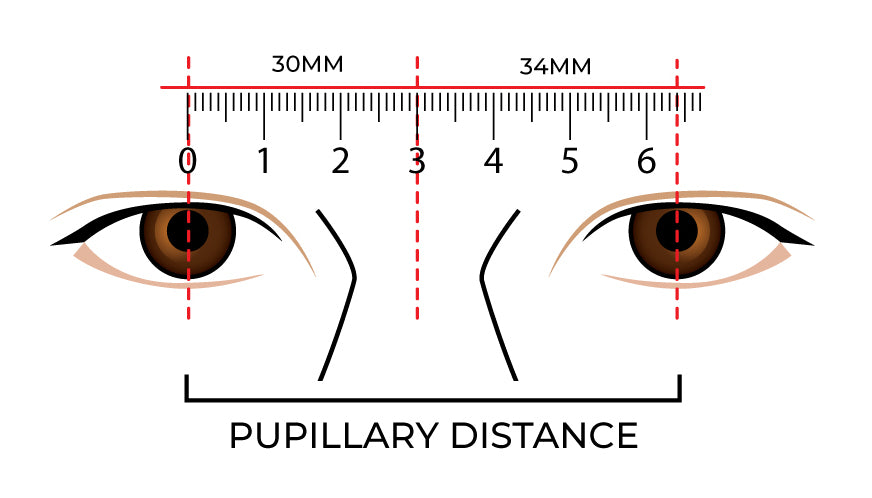Ordering items online sometimes gets tricky. You can’t know 100% if that shirt will fit, or if that table will look the same in person. Some of these difficulties don’t yet have easy solutions. When it comes to ordering prescription glasses, one of the questions you might ask is “what is pupillary distance (PD)?” or “How do I measure pupillary distance?” The answer is crucial to your online order, so don’t just shrug it off! We’ve got the lowdown on what exactly pupillary distance is, why it is important, and how to measure it.
What is PD?
PD stands for pupillary distance. Your PD’s number represents, in millimeters, the distance between your pupils. When purchasing glasses online, particularly prescription glasses, this number is crucial for proper fit. It tells you where your eyes are most frequently pointed in the glasses and thus how they should fit you best. When writing out your prescription, most doctors will measure this for you. If your prescription does not have it on it, we’ll explain how to measure it yourself!
What is Single PD vs Double PD
Single PD refers to the total distance, in millimeters, between the center of one pupil to the center of the other pupil. It will be just one number, such as 64mm.
Double PD is made up of TWO measurements: the distance between the right pupil and the bridge of the nose and then the distance between the left pupil and the bridge of the nose. This is often recorded at 32/32, with the right eye measurement as the first number.
What is the difference between the two measurements? In theory, the dual PD is more accurate as it measures the distance in each eye exactly, which is not always symmetric!. Having this exact measurement allows for each lens to be made exactly for your eyes!
Reading (Near) Vision Only Glasses
An important fact is that when we measure PD this is considered your distance PD. Your near PD is different because our eyes naturally converge (turn in) while reading so our PD changes slightly during this viewing distance.
If you are ordering reading only glasses, you can calculate your near PD by subtracting 3mm from your distance PD. If using the Dual PD method, it is recommended that you subtract 1.5 mm from each eye’s measurement.
Is PD Really That Important:
Having an accurate measurement of your pupillary distance is crucial to ensure clear, comfortable vision in your glasses. Even being off a few millimeters can induce prismatic effects depending on your prescription and type of glasses. This will result in the potential for blurred vision, double vision or just general discomfort with the glasses.
Does PD Change:
The answer is yes and no! For children, the answer is yes. As they are growing and their faces change, their PD will also change. As adults the PD should remain constant. However, it is standard of care to recheck your pupillary distance each time you get a new pair of glasses.
The average pupillary distance is 64mm for males and 61.7 for females. For kids the average PD range is between 43-58mm.
Pupillary Distance Ruler

If you’ve already got a ruler that measures millimeters at home, then you’re golden. If not, no need to run to the office goods store. You can easily find accurate downloadable millimeter rulers online. Simply find one of these rulers, like this one from Eyebuydirect, and print according to the instructions. The ruler should be long enough to measure between your pupils. As long as you have a printer at home, these online printable rulers offer a simple solution to a tricky problem.
How to Measure PD
The video above from All About Vision offers 2 easy methods for measuring pupillary distance at home.
Method 1: The Mirror
- Get a millimeter ruler
- Stand 8 inches from a mirror
- Hold the ruler up to your face
- Close your right eye
- Align the ruler's "0 mm" mark with your left pupil
- Open your right eye and Close your left
- Check what "mm" mark aligns with your right pupil. That number is your PD

Method 2: Glasses Wearers
- Get a millimeter ruler
- Find a washable felt-tipped marker
- While wearing your glasses, focus on an object 20 feet away
- Close your right eye
- Use the marker to cover the object as you see it in your left eye.
- Mark your glasses at that spot
- Repeat the same process for your right eye
- Use your millimeter ruler to measure the distance between the two. This is your PD
Online shopping has brought the world to your living room. Overcoming the small hurdles, like pupillary distance, should be a priority for anyone interested in benefitting from the amazing world of online glasses shopping. There's a huge selection of glasses now available online. This is more convenient than your local glasses store if you know everything you need to get the job done. Plus, there's even more glasses online than you'll find at any eyeglass store. Take advantage of the freedom of online glasses shopping today. Find out your pupillary distance, then check out GUNNAR's great selection of prescription glasses.





 UK site
UK site EU site
EU site US site
US site Canada site
Canada site